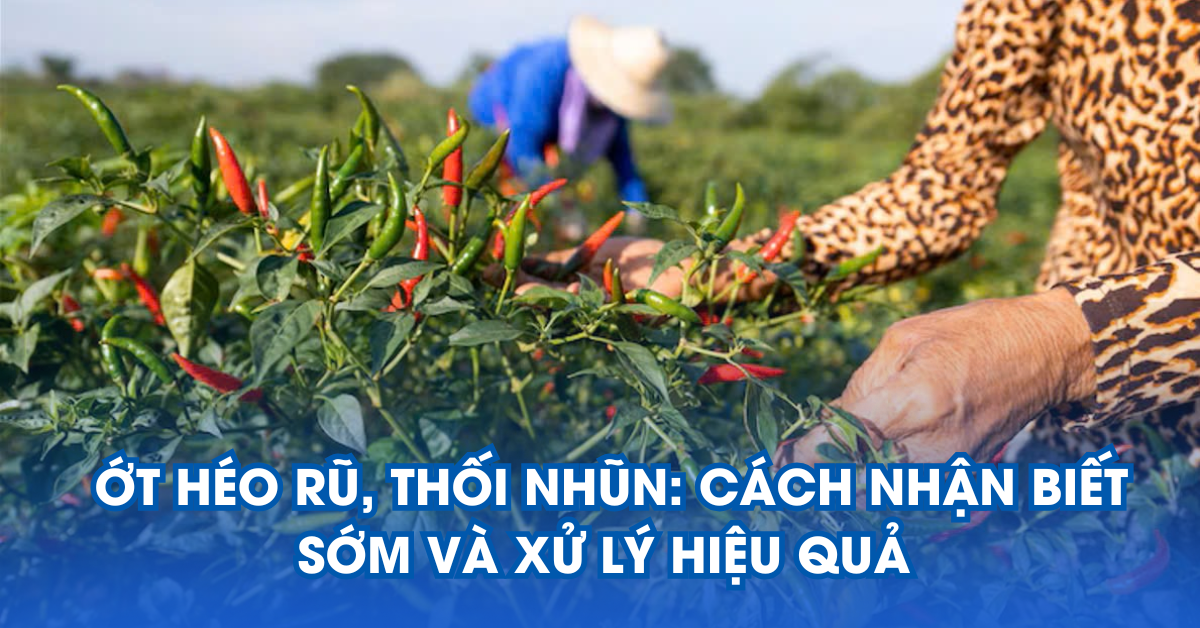Chili Wilt, Soft Rot: How to Recognize Early and Treat Effectively
19 May 2025

Chili wilt due to soft rot causes serious damage to the crop. Early recognition and proper treatment help farmers protect their chili gardens effectively during the rainy season.
Chili wilt, broken due to soft rot: Early recognition and proper treatment to save the garden
Chili is a crop with high economic value, favored by many farmers thanks to its ability to grow well and is suitable for many climates. However, during the rainy season or when the soil conditions are poorly drained, chili plants are susceptible to soft rot - a dangerous disease also known as "bacterial wilt", causing plants to collapse in large numbers in just a few days, causing heavy losses.
Chili plants wilt, broken stems due to bacterial soft rot. Photo: internet
Signs of wilt and soft rot on chili plants
The disease often starts suddenly and progresses rapidly, farmers need to pay special attention to the following symptoms:
- The plant wilts abnormally during the day but can recover when the weather is cool.
- After a few days, the chili plant begins to wilt completely, the stem softens and collapses, especially when bearing fruit.
- Observing the base of the stem near the ground, it is soft, oozing water, and has a characteristic foul odor.
- Diseased plants are easily broken when there is wind or when gently inspected.
- The disease spreads quickly, especially in densely planted fields, with widespread irrigation, or with mechanical injuries due to weeding, fertilization, etc.
Causes of wilt and soft rot
The main causative agents are bacteria such as Erwinia spp. and Pectobacterium spp. These bacteria exist in soil, irrigation water, and diseased plant residues and can easily break out in the following conditions:
- Wet soil, poor drainage.
- Long rainy season, high temperature, humidity exceeding 80%.
- Open wounds at the base of the tree create conditions for bacteria to invade.
- Improper crop rotation, growing chili continuously for many crops or planting after tomatoes, eggplants, etc.
Chili fields are flooded after rain, creating favorable conditions for wilt disease to develop. Photo: internet
Effective disease prevention and treatment solutions
1. Cultivation measures - "Prevention is the key"
To limit the risk of disease outbreaks, farmers need to prioritize safe cultivation measures:
- Make high beds, design good drainage ditches to avoid root waterlogging during the rainy season.
- Rotate with other crops such as beans and corn instead of planting chili with tomatoes or eggplants.
- Do not flood irrigate, use drip irrigation or ditch irrigation to keep the soil moist but not waterlogged.
- Disinfect pruning tools with alcohol or antiseptic solution.
- Clean up diseased plant residues after each crop to reduce the source of infection in the soil.
2. Microbiological and nutritional measures - Increase natural resistance
- Apply BASEOS microbial products containing beneficial bacteria strains such as:
- Bacillus megaterium: helps decompose insoluble phosphorus.
- Streptomyces beta-vulgaris: antagonizes fungi and pathogenic bacteria.
- Burkholderia sp.: improves soil, increases root resistance.
- Use Con Co BASEOS NPK fertilizer 20-10-10+6S+0.045B from the seedling stage to help plants grow healthily, with thick leaves, strong roots and increased disease resistance.
3. Chemical measures – Use only when absolutely necessary
When the disease breaks out, early intervention with specific drugs is needed:
- Spray drugs containing the active ingredients Kasugamycin, Ningnanmycin or Streptomycin according to technical instructions.
- Choose the time to spray early in the morning or cool afternoon, avoid strong sunlight and rain immediately after spraying.
Note: Do not overuse chemicals to avoid drug resistance and affect beneficial microorganisms in the soil.
Goal of protecting productivity and sustainable development
Prevention of wilt - soft rot not only helps protect the current crop but also contributes to maintaining soil fertility and health for the following crops. Synchronously applying cultivation measures, using microorganisms and proper nutrition will help farmers:
- Reduce the cost of pesticides.
- Increase the yield and quality of chili.
- Prolong the harvest time and life of chili gardens.
- Ensure safety for users and the surrounding environment.
Conclusion
Wilt and soft rot diseases on chili plants are serious threats to growers during the rainy season. However, if farmers recognize them early, cultivate properly, and combine appropriate microbiology and nutrition, they can completely prevent and handle them promptly, saving the entire crop from damage.
Views
597
